Kkakdugi is a type of kimchi made from diced radish. It’s a very common kind of kimchi and often used in Korean everyday meals along with baechu kimchi (napa cabbage kimchi). It’s spicy, salty, delicious, and is incredibly crunchy. Best of all, you can make perfect kkakdugi in an hour!
I posted a video about how to make kimchi in 2007, when I had just started using YouTube. I showed how to make both baechu kimchi and kkakdugi in a single video, but I didn’t provide exact measurements as I wasn’t accustomed to measuring things out at that time. I mentioned things like “you need 2 medium sized napa cabbages…” But I soon realized that it would be diffcult for people to make their own kimchi without knowing the exact pounds, kilos, cups and spoons etc. Also, 2 major recipes in one video is a lot for people to learn!
So last year I posted an easy kimchi recipe that calls for 10 pounds of napa cabbage, and I tried to do my best to provide accurate measurements so that my viewers and readers could make delicious kimchi. Now I’m posting a more detailed kkakdugi recipe today, a recipe I have developed over years and years and is the best I have made so far.
I hope you enjoy it! Good luck in your kimchi-making!
Ingredients
- 4 pounds Korean radish (or daikon)
- 2 tbs kosher salt
- 2 tbs sugar
- ¼ cup fish sauce
- ⅔ cup Korean hot pepper flakes (gochugaru)
- 4 stalks of green onions, chopped
- 2 tbs minced garlic (about 5 or 6 cloves garlic)
- 1 ts minced ginger
Directions
- Peel Korean radish, rinse in cold water and pat dry.
- Cut it into ¾ to 1 inch cubes. Put into a large bowl.


- Add kosher salt and sugar, and mix well.
*tip: If you like your kkakdugi sweeter, add 1 or more extra tbs of sugar. - Set aside for 30 minutes.
- Drain the juice from the radish into a small bowl.
- Add minced garlic, minced ginger, green onions, fish sauce, hot pepper flakes, and ⅓ cup of the juice from the radish.
*tip: The amount of hot pepper flakes you use depends on your taste; use ¼ cup hot pepper flakes for a mild version. For a vegetarian version, replace fish sauce with soy sauce.


- Mix it up well until the seasonings coat the radish cubes evenly, and the radish looks juicy.
- Put the kkakdugi into a glass jar and press down on the top of it to remove any air from between the radish cubes.

- You can eat it right away, and then store it in the refrigerator. Or you can let it ferment by keeping it outside of the refrigerator for a few days. When it starts fermenting, little bubbles may appear on top of the kkakdugi and it’ll smell strong & sour. Then put it in the refrigerator.

Kkakdugi goes well with many Korean soups, including kongnamulguk (soybean sprout soup) and ox bone soup.
Maangchi's Amazon picks for this recipe
It's always best to buy Korean items at your local Korean grocery store, but I know that's not always possible so I chose these products on Amazon that are good quality. See more about how these items were chosen.





































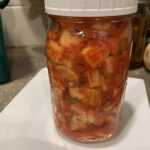
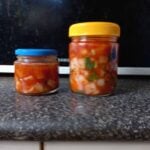
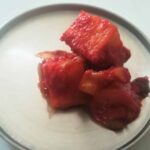




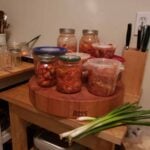
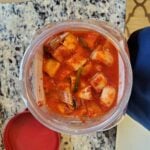
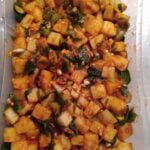
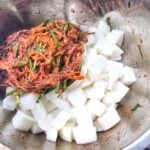
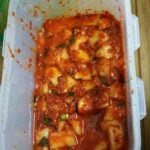


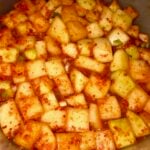

I made this over the weekend and it is so delicious! I honestly can’t stop thinking about it. This was my first time making anything like this and it was so easy. I will definitely make it again, thank you for sharing this!
I made the traditional Napa cabbage kimchi (which was delicious btw) and have leftover paste. I know you said it could be frozen but could it be used on the radish I have from the recipe too?
Yes, you can use the paste to make radish kimchi, too.
Can I use this same radish recipe with Napa cabbage kimchi? I like this exact taste!
Thanks for recipe! It’s now my favourite kimchi recipe as it’s cheaper and easier for me to make than napa kimchi. And I really like the level of spiciness.
The first time I made it the kimchi turned out fantastic, but the second time it was too salty.
Should I reduce the salt, leave the radish to sit with the salt and sugar for a longer or shorter time, put less of the juice back in, or try something else?
Waiting for the juice coming out in a couple of days!
See full size image
Wow, it looks mouthwatering!
Now addicted to this crunchy radish kimchi! Making it again tonight :D
Now addicted to this crunchy radish kimchi! Making it again tonight :))
Hi Maangchi, I made radish kimchi and beef radish soup to make a “complete” Korean meal. Thank you.
See full size image
Oh you made spicy version radish and beef soup! https://www.maangchi.com/recipe/maeun-muguk I see you added more vegetables such as soybean sprouts. It looks so good!
Hi Maangchi and everyone!
I am growing Daikon in my garden and making your kimchi.
The daikon in the garden have a lot of leaves.
Do you add these to the kimchi?
This picture is a variety called Alpine Gold.
It grew to this size in 60 days in the hottest part of the year.
It’s about 1 1/4 pound and the main part is 9 inches long.
Very nice raw, not too hot, and right out of the refridgerator – so nice!
It’s kimchi now.
See full size image
Wow, the radish looks gorgeous!
When we make diced (cubed) radish kimchi, we usually use only radish but you can make different style kimchi. Check out this recipe. https://www.maangchi.com/recipe/chonggak-kimchi
Kkakdugi!!!
The store had imported Korean radish on sale. It tastes sweeter than the US ones I’ve been getting lately. Sooooooo goooooooood!
See full size image
Delicious! Yes, good radish makes good kkakdugi.
Sweet, crispy, juicy, and firm radish is good quality.
Hi, I made my first pickled radish following the exact amount of ingredient. After leaving the jar outside for a day, noticed it was watery at the bottom and a lot of bubbles at the bottom. Is the pickled radish ok? Can I stir the contents at the bottom or just scooped from the top? Thanks!
See full size image
It’s fermenting, that’s OK – but press it down to remove any bubbles.
Thank you for the recipe, I used normal smaller radish, not daikon, hope it’ll turn out fine. I omit the fish sauce and used chives instead of the green onions. It smells amazing, now I just have to wait for it to ferment maybe for 3-4 days. I really love your blog and finally made a profile. Keep creating Maangchi. Love from Indonesia.
See full size image
Also, depending on the radish, pickling the cubes 10-15 min more gives a better result. Mines were not crispy, nor juicy that much. This one, I just made it! Happy kimchi days!
See full size image
Hi, I want everyone here to know how important to follow Maangchi’s recipe exactly. If you put more salt in it, please don’t add more radish cubes. Slightly more salt is Okay, but not less! This is what I made two days ago.
See full size image
Yum yum! Super easy!!!
See full size image
I feel like eating a piece of your kkakdugi. Where are my chopsticks! : )
Hi Maangchi. Can I use your recipe for vegetarian kimchi to make cubed radish kimchi?
Hello Maangchi!! I’ve made this several times and absolutely LOVE it as do my friends and family! However, now there is only me and I want to make a much smaller version. I’m not sure how to get the ratio correct from radish to ingredients – salt, sugar, gochugaru, green onion, garlic, ginger and fish sauce. I use vegan fish sauce, by the way. I’m not good at conversions and wanted to know if you could maybe make a video of using a much smaller radish/daikon, etc? Or maybe someone here can help me? Thank you so much!!
I had a bit of radish I needed to use and this was my reduced recipe (US measures):
1 pound daikon radish, cubed
1 1/2 teaspoon kosher salt
1 1/2 teaspoon sugar
2 1/2 teaspoon fish sauce
5 teaspoon Korean hot pepper flakes
1 green onion, sliced
1 clove or 1-2 teaspoons minced garlic
1/4 teaspoon minced ginger
Hope this helps someone.
I forgot to include:
2 teaspoons left over juice
My home-made Kkakdugi…delicious delicious..
See full size image
Hi Maangchi, just wondering if there is anything I can do with the leftover salt+sugar+radish juice brine. Can I use it to brine something else? Seems like a waste to throw it out!
Brine meat with it. Seriously.
Hello
Can I use this recipe with regular cabbage?
I’ve made kkakdugi twice now, using jicama, instead of joseonmu or daikon. It’s turned out very good.
See full size image
Would there be a way to make this with more juice? I’m going to separate it into several jars for gifts, and I want to be sure there’s enough liquid in each jar to cover the radish. Thank you! =)
This is so easy and really yummy. A great snack.
Hello Maangchi! I want to make this recipe based on your book. Should I rinse it as you directed here?
Also can I add or substitute salty shrimp (Saeu-jeot) for the fish sauce? I know it’s saltier so I may mix the two a little. I have some leftover shrimp from kimchi and want to use it up. Thank you!
Hello,
New to the site and to making Korean food myself (but a big fan). This is the first recipe I’ve tried. It is jarred and sitting out to ferment. I noticed however, that when using the recommended amount of fish sauce it smelled fishier when jarring than that which I buy at the Korean grocer. Will this attenuate a bit with fermentation?
Also, I had Gochugaru powder instead of flakes. I couldn’t find a conversion from flakes-to-powder. I suspect it would be less than 1:1 (based on how hot my son’s Korean cooking is using the powder). Do you recommend differing amounts of powder versus the more course flakes?
Thanks! Happy to have discovered this site. Plan to try many of the recipes now that I have stocked my pantry. Cheers!
Fresh kimchi does generally taste fishier and saltier at the start. But once it has fermented, the flavours mellow out and you can’t taste the individual components. Hope that helps!
Hi Maangchi,
I tried making kkakdugi yesterday but I am not sure if I was successful because I didn’t smell any sourness. I come from a hot and humid country so I am not sure if that is tha cause. Anyway, I kept the kkakdugi in my warm kitchen (about 30C) for 18 hours and have moved it to the fridge for fear of spoilage.
Thanks for the recipe. I enjoy your demonstration a lot.
See full size image
It looks so good! I’m sure your kkakdugi is fermented now and you are enjoying it very much!
Hello maangchi… I made this radish kimchi last month .. My first ever Korean dish ..since I started making it, it’s my mom’s favorite dish .. watching and trying your recipes are Big help during this lockdown .. stay safe :)
See full size image